This episode of Light Hearted was originally released on July 12, 2019. You can listen with the player below. The entire transcript follows. This was the third of three “Cape Cod Week” episodes. Jeremy D’Entremont interviews Gary Childs, chair of the Cape Cod Chapter of the American Lighthouse Foundation. The chapter cares for three lighthouses in the vicinity of Provincetown on Cape Cod, Massachusetts: Race Point, Wood End, and Long Point. Co-host Michelle Jewell Shaw and Jeremy discuss early lighthouse illumination.
JEREMY
You are listening to Light Hearted, the official podcast of the United States Lighthouse Society. My name is Jeremy D’Entremont. This is the third and final of three editions of Light Hearted we’re releasing this week for Cape Cod week. And my co-host again today is Michelle Jewell Shaw, and we are coming to you again from the semi-luxurious study room three of the Portsmouth Public Library here on the New Hampshire Seacoast. Hi Michelle, I’m hoping you have another fun fact about Cape Cod.
MICHELLE
Hello Jeremy. I most certainly do. Provincetown, at the tip of Cape Cod, is where the Pilgrims first landed before they moved on to Plymouth. It’s also home to three lighthouses. And Provincetown is also home to the tallest all-granite structure in the country, the Pilgrim Monument. The monument was built from August 1907 to August 1910. It’s 252 feet tall, and it’s open for climbing. It’s next to the Provincetown museum, which highlights the town’s rich maritime history.
JEREMY
Have you climbed the Pilgrim Monument?
MICHELLE
I have not. I’ve seen it, but I have not climbed to the top.
JEREMY
Well, you should.
MICHELLE
I know. Next time I’m there.
JEREMY
Okay. I’ve climbed it. It’s an amazing view. You can see Provincetown’s three lighthouses from the top — Long Point, Wood End, and Race Point, which is right at the tip of the Cape. Our guest today is the chairman of the Cape Cod Chapter of the American Lighthouse Foundation, which takes care of those three lighthouses in Provincetown. And today we’ll mostly talk about Race Point Light Station. Race Point’s name comes from the strong crosscurrent known as a race that made navigation around the tip of Cape Cod a nightmare for mariners.
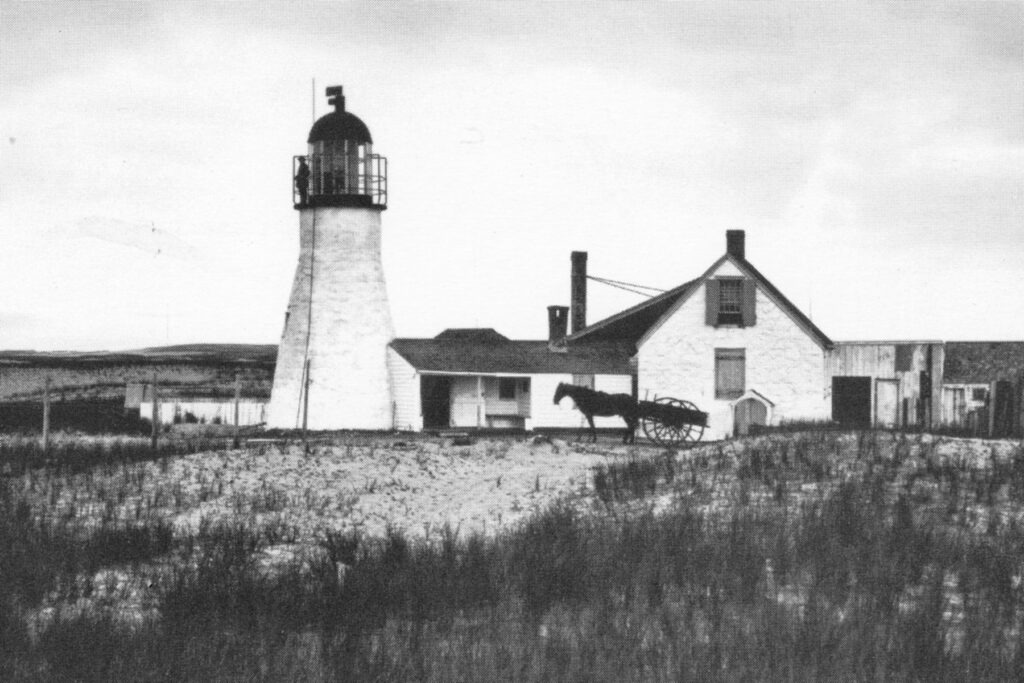
MICHELLE
The first lighthouse at Race Point was built in 1816. The cast-iron tower that stands today was built in 1876. After the light was automated in 1972, the keeper’s house was bordered up and the property was abandoned. In 1995 the station was licensed to the New England Lighthouse Foundation, which is now known as the American Lighthouse Foundation or ALF. The keeper’s house has been restored to the 1950s era. And the five-bedroom house is open for overnight stays. The former fog signal building or whistle house is also open for overnight stays.
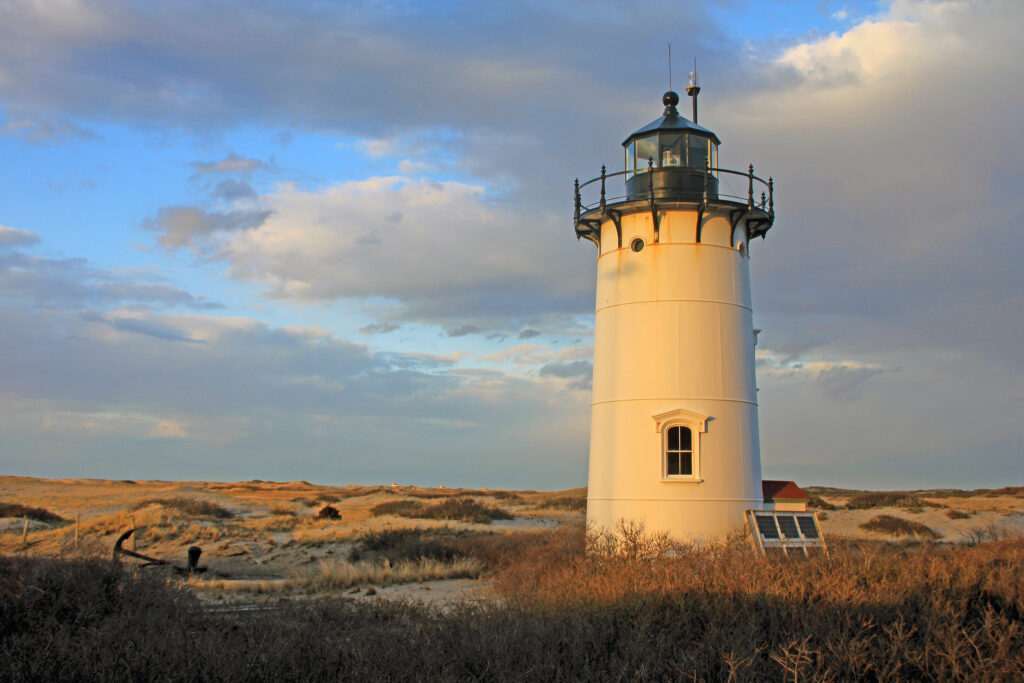
JEREMY
Gary Childs, a retired firefighter and paramedic, is chairman of the Cape Cod Chapter of the American Lighthouse Foundation. We recently spoke at the Nonantum Resort in Kennebunkport, Maine, just before the annual gala dinner of the American Lighthouse Foundation. Let’s listen to that conversation now.
JEREMY
We are talking here at the Nonantum Resort in Kennebunkport, Maine, just before the annual gala dinner of the American Lighthouse Foundation. So I do want to explain that if you hear any background noise, and that includes traffic, it’s because we’re actually out on the front porch area right near the road here. So you might hear a little traffic.You might hear a little conversation in the background, but again, are at the Nonantum Resort here in beautiful Kennebunkport. And I want to thank you, Gary, for spending some time with me here. Thank you so much.
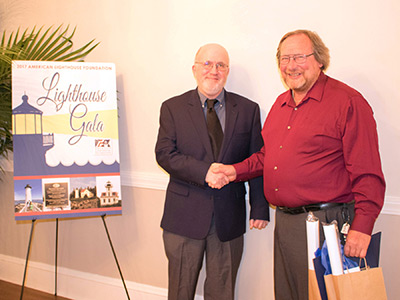
GARY CHILDS
Thank you very much, Jeremy. It’s good to see you again.
JEREMY
So, Gary, you’ve been involved with the Race Point Light Station for quite a few years. How long has it been now?
GARY CHILDS
I did the math the other day and it works out to be 15 years just about. I went out there as a guest in 2005 and fell in love with the place. And after a couple of years I was invited to become a keeper out there, where we watch over our guests that are there to make sure they’re safe, and then was moved up onto the board and then moved up to number two. And then about five years ago, I took the helm out there with a very strong crew of about 70 volunteers that make the place run.
JEREMY
Wow, that’s amazing. I know you have a great crew there. The isolation of Race Point Light Station, I would say, is both a blessing and a curse. It makes it a beautiful place for people to get away, but also I would say it makes getting anything done there kind of a nightmare. Can you talk a little bit about the logistics of getting work done out at Race Point?
GARY CHILDS
Well, we’ll go with the fact that we do our bookings. They open up in October for our keepers and November for the general public. So before we’ve even ended one season, we’re already starting the next season. So there’s paperwork in the background. And then on Thanksgiving directly after that, we shut the place down, like any cottage on the Cape, and drain the water, secure the buildings, whatever we need to keep an eye on the place. So in the winter, about every 10 days, we make a trip out there. As long as the weather and the two-mile sand road is passable, to keep an eye on the place. And then about the beginning of March, we go out like every other place on the Cape, turn the water on, find out where the leaks are, get rid of the mice that come into the building, and start the general checklist of what needs to be done.
Being two miles down the sand road, in the preseason, is a bit of a challenge. We never know what the beach is going to present to us. The last two years the beach has been impassable on the back road and we’ve had to run the outer beach. The inner beach is now open for this year’s logistics of work. So two years ago, three nor’easters consecutively took shingles off one side of the house and we were unable to get out there and affect repairs, and ended up with close to about $5,000 worth of materials that needed to be replaced from the roof to insulation, to sheet rock, to wiring, to painting, to tile on the floor. So we ended up with a dozen volunteers to get out there and make the work on a place and still meet the third week of April deadline to get the building out in operation during the year. Our logistics for trying to get out there for work or anything else is for about two months. The piping plover, a threatened species, can interfere with our ability to get out there. And we have to go with an escort at prescribed times of the day. And it’s always interesting with our tradespeople to get them out there, we have to make sure all the permits are in place for them to move. But it is a jewel at the end of the beach.
JEREMY
Yes, it is. Let’s talk a little bit more about the overnight stays at Race Point. There are rooms available in both the keeper’s house itself and also the fog signal building, which is usually referred to as the whistle house. Can you tell us a little bit about the accommodations themselves?
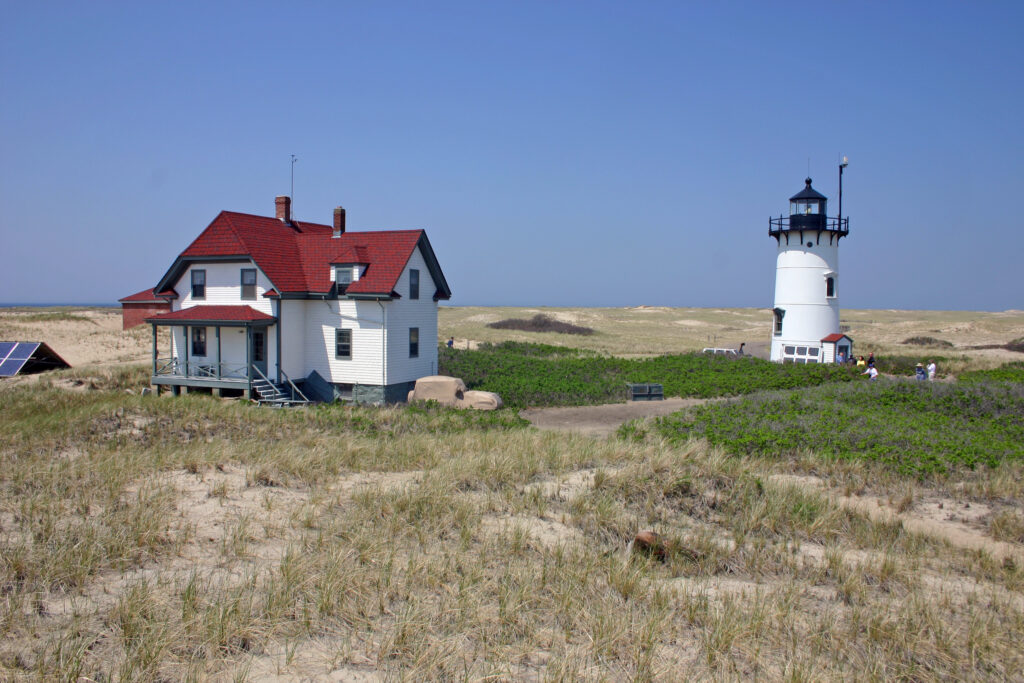
GARY CHILDS
Sure. In the keeper’s house, the keeper that’s in residence stays downstairs in the bedroom down there to act as a taxi driver, if you will, as we pick people up and bring them out. They bring their own drinking water, their own sheets, their own pillowcases. We have the pillows, we have the beds, we have the blankets, we have everything else. So our keepers are not concierges, but they make the place run. Upstairs there are three rooms that accommodate three. In one room, in the blue room, and in the yellow room, which is the most popular room, accommodates three plus one. That looks out at the ocean and also looks at the lighthouse. And then the green room on the south side of the house that looks out over the water, that will take two plus two plus one. So five max that are out there. We provide all transportation for those folks.
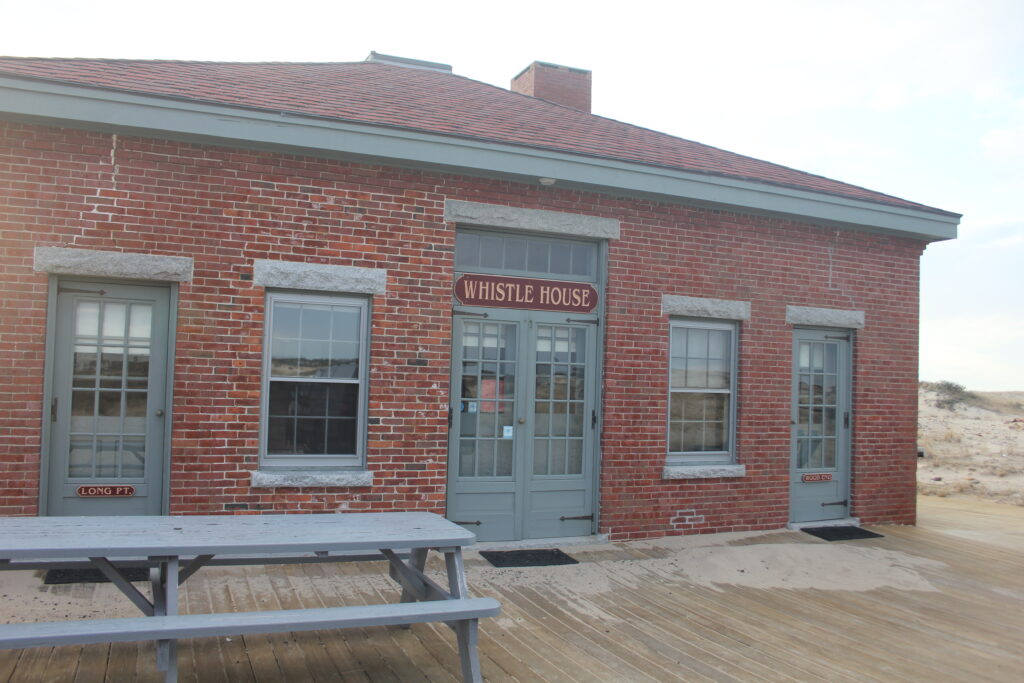
The folks that are in the whistle house, which is a one-story brick structure and is set up as two separate apartments, people have to provide their own transportation and get a permit from the national park. Typically, during the summer, that’s a weeklong stay. And they come out. Again, they’re pretty much on their own. We make sure that they’re not, nothing goes damaging with them. And then in the off-season, they come out for a minimum of two nights.
Back to the keeper’s house. For one thing, we decided locally that we would not have a two-night minimum. We specifically wanted to have a one night so that people could try it, see if they like it. And strangely enough, we put a four-night cap on it so that people don’t stay out for a full week or two weeks. We want as many people to see the property and enjoy it in alignment with our mission statement. We get phone calls. Can we book the place for the month of August? And we say, sorry, we don’t work that way. We’re trying to get as many folks in there who can see the place as possible from both the States and international.
JEREMY
Now, if people want to visit the light station, but they’re not staying, I understand there are also public open houses during the summer. Can you say a little bit about how those work?
GARY CHILDS
So we start in June and we go to October, and we do the first and third Saturdays of the month. Our volunteers are out there to handle the lighthouse tours directly. So people either hike out and we get many day trippers that come out or they come out in their own private RVs — that too. And we have to pay attention to — there’s a transport agency. That’s been out there since the forties — Art’s Dune Tours. And they come out on Sundays and bring folks out to the lighthouse. And there’s a bit of money exchanged over that. They do well and we get a little something on that end of it. We do request a donation to help keep for the preservation and restoration of the lighthouse. Everything up there is exposed to the salt and the salt air. And that takes a heavy toll.
JEREMY
You mentioned earlier that you have somewhere around 70 volunteers, which is fantastic, a very dedicated group of volunteers. Can you say a little bit more about what’s required to be a volunteer for Race Point?
GARY CHILDS
The specifics are on our website, which I’ll talk about later, but we require that to become a volunteer, they have a data form to fill out and we look for people who are handling all the different trades and such, and also “people people.” We like them to spend several nights out there to understand what the place is all about as a guest first. And then at the local level, we look at the group and decide how many we need. And usually we like people in pairs, because we like to have a duplication. If something goes wrong, there’s a backup out there, and kind of discourage solo keeping, but we do pair people up that are solos to make it work. What’s required is the volunteers, first, they have to belong to the American Lighthouse Foundation, dues there. And that also covers them for liability for driving our vehicles. They then come out and again they make sure that people, all their belongings get out there and they keep an eye on them. And they have to kind of find a line between being a historian or allowing the person who’s seeking solitude to have the room they want without any intrusion. So it’s kind of an interesting mix with that. On top of that, we require them to do 10 hours a year per person for other projects, be it lighthouse tours or painting, or going out to our other two lights and doing some work out there. And inevitably there’s a punch list on the wall and people can pick what they feel most comfortable doing. We have another group of volunteers that were just out there two days ago, and that’s the final group that follows the work group in April. And they go out and paint. When the painting’s all done, they put the rugs down, put the shades up, and they make sure the place is completely presentable from May one.
We have people come and go. We’ve had long-term people. We’ve had people whose lives get a change in their life and they choose not to do it again. And that’s fine. We’re good with that. About every two years, we hold another volunteer group orientation, which is a two-day project. Their first day is a PowerPoint all day with lunch where we kind of cover everything about what makes it work. And then on day two, we go out to the house and they get some over-sand operations and we go through the whole place and we literally crash the building. We shut down the electrical and they draw on the keeper’s manual and go through the steps of how to restore power in the house and handle the small emergencies that show up. We are very fortunate. We have a large group and very dedicated folks.
JEREMY
Obviously, volunteering at Race Point Lighthouse is a big part of what the Cape Cod Chapter does, but are there other things that the volunteers do besides working at Race Point Light Station?
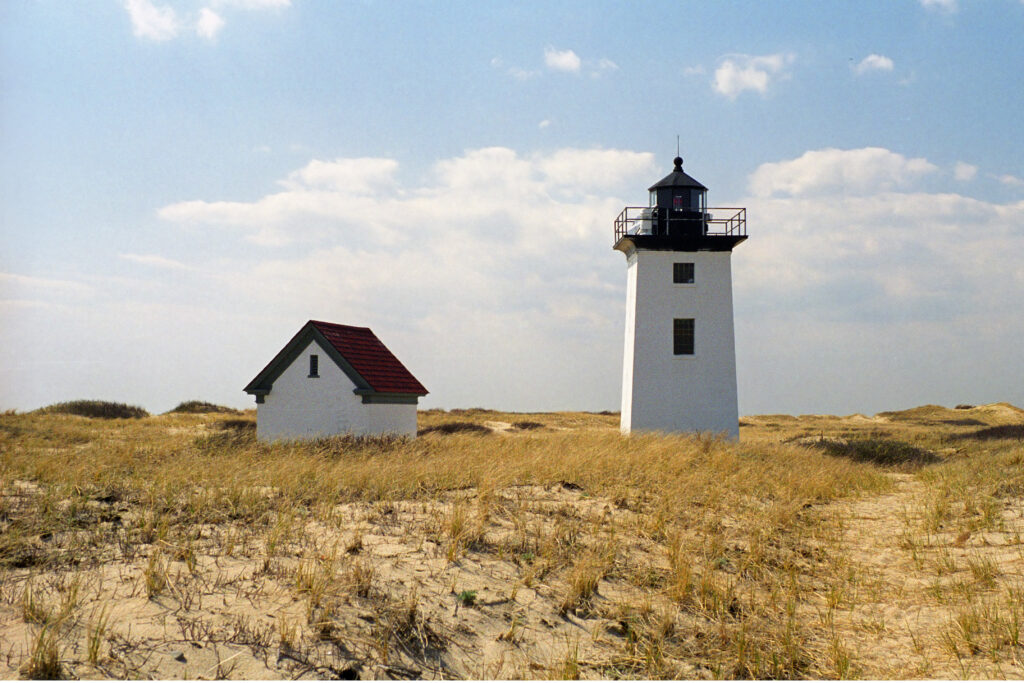
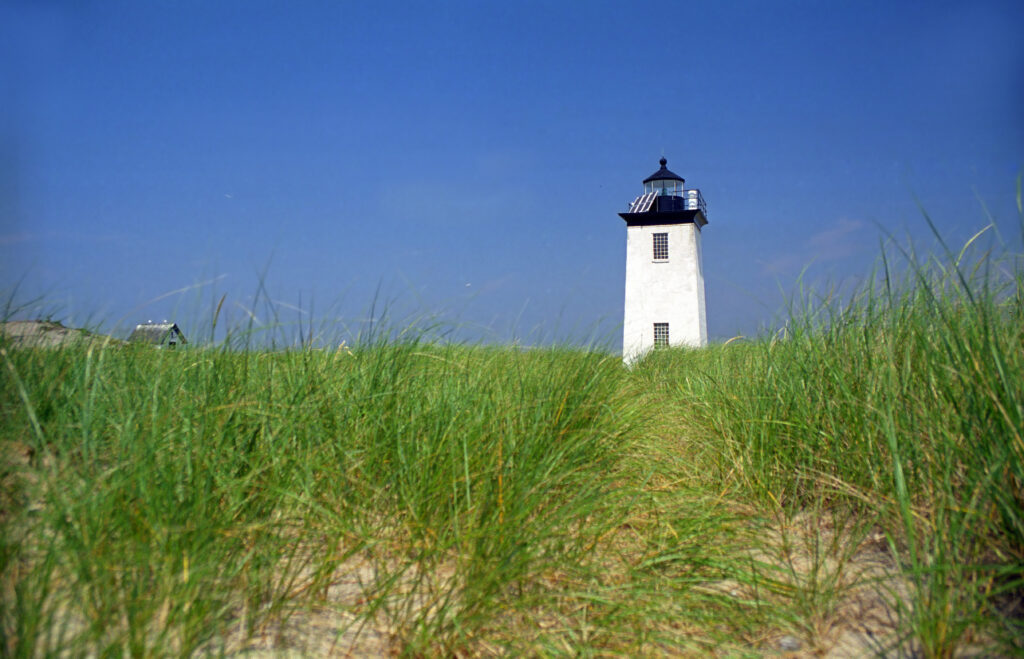
Long Point Lighthouse
GARY CHILDS
So besides Race Point, we also, in our charter, have some exposure to the other two lights in Provincetown at Wood End and Long Point, both on the outer beach. And about every four years, we paint those two lighthouses on the exterior. The Coast Guard maintains the optics, the bulb, if you will, the lantern, the LEDs, and the power and the batteries. But as far as security or anything else like that, or painting the structures, we do that on a volunteer basis for those two lights. We unofficially also help out with Sandy Neck Light, another ALF chapter, which we actually have an easement on. So we make sure that that lantern out there stays lighted and about every 10 weeks or so, I make a trip out there to replace the batteries. We make sure it’s working and then yearly change the batteries out there to make sure that lantern stays lighted.
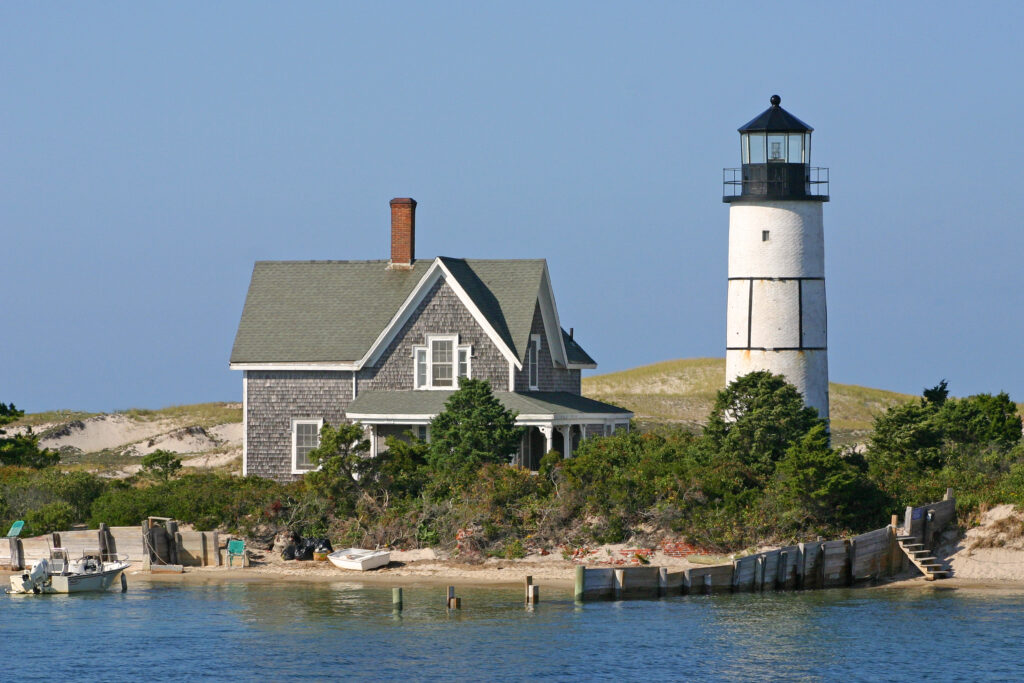
JEREMY
How can our listeners find out more about Race Point Lighthouse and the Cape Cod Chapter of the American Lighthouse Foundation?
GARY CHILDS
So there’s a couple of ways. While we’re a historical chapter and we’re on the historical register, we’re also tied to the 21st century. So we do Facebook and other media related, social media. So we have a Race Point Facebook page. We’re also on the web. So we are at racepointlighthouse.org, all one word, Race Point lighthouse.org, and our website can explain all the histories and how to turn around and get ahold of us. And we also do Constant Contact and we do a Twitter account as well. So we, as much as being historical building, we have people out there who are booking a room on their phone as they’re standing out there. And we do, we have people every once in a while will walk up. Our foreign, international folks, we provide their linens and we will pick people up at either our traditional spot right off of Route Six. We also pick people up at MacMillan’s Wharf. And we also pick people up at the airport, and if they come in by the fast ferry, so anyway, one way or the other, we make it all work.
JEREMY
So Gary, is there anything else you’d like to add? Anything you’d like to tell them, if you could tell people one thing about Race Point Lighthouse and/or the Cape Cod Chapter of the American Lighthouse Foundation, what would you like to tell people?
GARY CHILDS
People are always blown away when they come out there and they find out that they can sit on the porch and be about 150 feet away from the water and listen to the whales breach, listened to the whale watch boats go by. And when the busy-ness stops at the end of the day, they have the solace out there of the sun setting on one side and the sun rising on the other. And occasionally we shut out all of the lights in the building, and there’s only one light out there. That would be the lighthouse. The every 10-second white flash. People walk away from that place with their souls restored. I think the thing that we’ve used over the years from Jim Walker and other folks that are there as we stand on our predecessors’ shoulders is the guestbook. And the guestbooks from both buildings are filled with returning and first-time people who are experiencing the solitude and the peace out there.
JEREMY
It’s a really special place. I certainly agree with that. I go back over 30 years, the first time I walked out there with my wife, it was all boarded up. And to see what what’s taken place there over the years, the progress that’s been made that you guys have really pulled off miracles there. And I congratulate you on that. So thank you so much for being with me today, Gary, I really appreciate your time and I will be seeing you in a few minutes at the American Lighthouse Foundation gala dinner. So thank you so much, Gary.
GARY CHILDS
Thank you very much.
MUSIC
JEREMY
On today’s lighthouse history segment, we’re going to discuss early lighthouse technology, specifically the various kinds of illuminants and apparatus that were used in the early days of lighthouses before the important invention of the Fresnel lens in 1822. I want to give credit to Tom Tag of the U.S. Lighthouse Society, who is the guru of lighthouse technology. Much of what we’re about to tell you comes from his research, and you can find many fascinating articles by Tom about lighthouse history and technology on the USLHS website at uslhs.org.
MICHELLE
The earliest navigational lights used simple open fires that usually burned wood. As time passed, the fires were contained in iron baskets known as braziers and soon coal was often used as the fuel. The Dungeness Lighthouse in England in the early 1600s burned as much as 400 tons of coal each year. Smoke was often a problem with the coal-fired lights.
JEREMY
In the age of the coal-fired lighthouses, the lights were eventually enclosed in lanterns with ventilating flues in an attempt to get rid of the smoke. Meanwhile, candles were used in some lighthouses as early as 1540 in England. The candles were placed in a candelabrum or chandelier kind of arrangement, surrounded by a lantern with glass windows.
MICHELLE
When it went into operation in 1698, the first Eddystone Lighthouse in England used sixty one-pound candles. A few years later, when the first lighthouse in the American colonies went into service in Boston Harbor, it used wax or tallow candles.
JEREMY
Simultaneously with coal fires and candles, primitive oil lamps were used in some lighthouses by around 1500. Some of the early lamps were nothing more than stone bowls filled with oil, with one or more small wicks. Different oils were tried, including fish oil, seal oil, and eventually whale oil. These primitive lamps and wicks produced a very poor flame.
MICHELLE
In the 1700s, so-called spider lamps, which used multiple wicks, became popular. By the 1760s, a type of spider lamp called the pan lamp was used in many lighthouses. The pan lamp had as many as 24 wicks and could operate for as long as 12 hours on a single fill of oil. Although they produced a lot of smoke and fumes, pan lamps were used for nearly a century. Other types of spider lamps were also used for many years.
JEREMY
Then, in 1780, a Swiss physicist living in France, Francois-Pierre Ami Argand, patented a very important invention – the double draft burner, which became known as the Argand lamp after its inventor. The Argand lamp used two thin metal tubes, one inside the other. A wick, in the form of a long hollow cylinder, was placed between the two tubes. Air can pass both through the center of the wick and also around the outside of the wick before being drawn into the cylindrical chimney, which steadies the flame and improves the flow of air. Argand lamps would be widely used in lighthouses.
MICHELLE
The Argand lamp was introduced to Thomas Jefferson in Paris in 1784 and according to Jefferson it gave off a light equal to six or eight candles. Argand lamp burned whale oil, seal oil, or vegetable oils as fuel. In 1787, another inventor created a constricted chimney that created a brighter flame. And in the early 1800s, the Scottish engineer Robert Stevenson paired Argand lamps with copper parabolic reflectors at the Bell Rock Lighthouse. He placed 24 of the lamps and reflectors in an arrangement that revolved with the use of a clockwork apparatus, producing an alternating red and white light. It was the first revolving light in Scotland.
JEREMY
In the next lighthouse history segment on this podcast will discuss the American appropriation of the argon lamp and reflect your technology by Winslow Lewis and his monopoly on American lighthouse lighting in the early years of the 19th century.
NOTE: The trivia contest is now closed.
MICHELLE
What was the name of the Swiss physicist living in France who invented an improved oil lamp around 1780 that was used widely in lighthouses? Again, what was the name of the Swiss physicist living in France who invented an improved oil lamp around 1780 that was used widely in lighthouses? We just mentioned this a minute ago, so listeners should know it if they were paying attention.
JEREMY
And I’m going to make an executive decision here and I’m going to say they just need to tell us the last name.
MICHELLE
That sounds, that sounds fair. His name’s a bit of a mouthful.
JEREMY
Yeah, of course they can Google this and find his name. But they shouldn’t do that, though. They should listen. They should have been listening so they shouldn’t have to Google it. But anyway, the first person to answer the question correctly gets a copy of the book Lighthouses of America, published in association with the U.S. Lighthouse Society. The book Lighthouses of America is a beautiful 176-page hardcover book with stunning photographs of lighthouses across the country, taken by Society photographers.
MICHELLE
The second person to answer correctly gets an official U.S. Lighthouse Society passport. The lighthouse passport program provides enthusiasts the opportunity to help preserve lighthouses as well as a wonderful way to keep a pictorial history of their lighthouse adventures. You can learn more about the passport program at uslhs.org,
JEREMY
To enter, send your answer in an email to me at jeremy@uslhs.org. Be sure to say you’re answering the trivia question in Light Hearted episode 13, and again, send it in an email to jeremy@USLHS.org.
MICHELLE
That wraps up this edition of Light Hearted and it wraps up Cape Cod week on Light Hearted as well.
JEREMY
Thanks as always to the wonderful volunteers and staff of the USLHS at no point in Washington and all around the world. And of course, thanks to our guest, Gary Childs of the Cape Cod Chapter of the American Lighthouse Foundation. Be sure to check out racepointlighthouse.org online.
MICHELLE
Be sure to check out the U.S. Lighthouse Society website at uslhs.org for information on their domestic and international tours, the J Candace Clifford Lighthouse Research Catalog, the passport program, and lots of other fun and interesting things. Also check out news.uslhs.org for lighthouse news and other feature, and the USLHS social media pages on Twitter, Instagram, and Facebook.
JEREMY
Thanks so much as always, Michelle, for co-hosting this edition of Light Hearted and all the editions during Cape Cod week. And until next time
MICHELLE
Keep a good light!
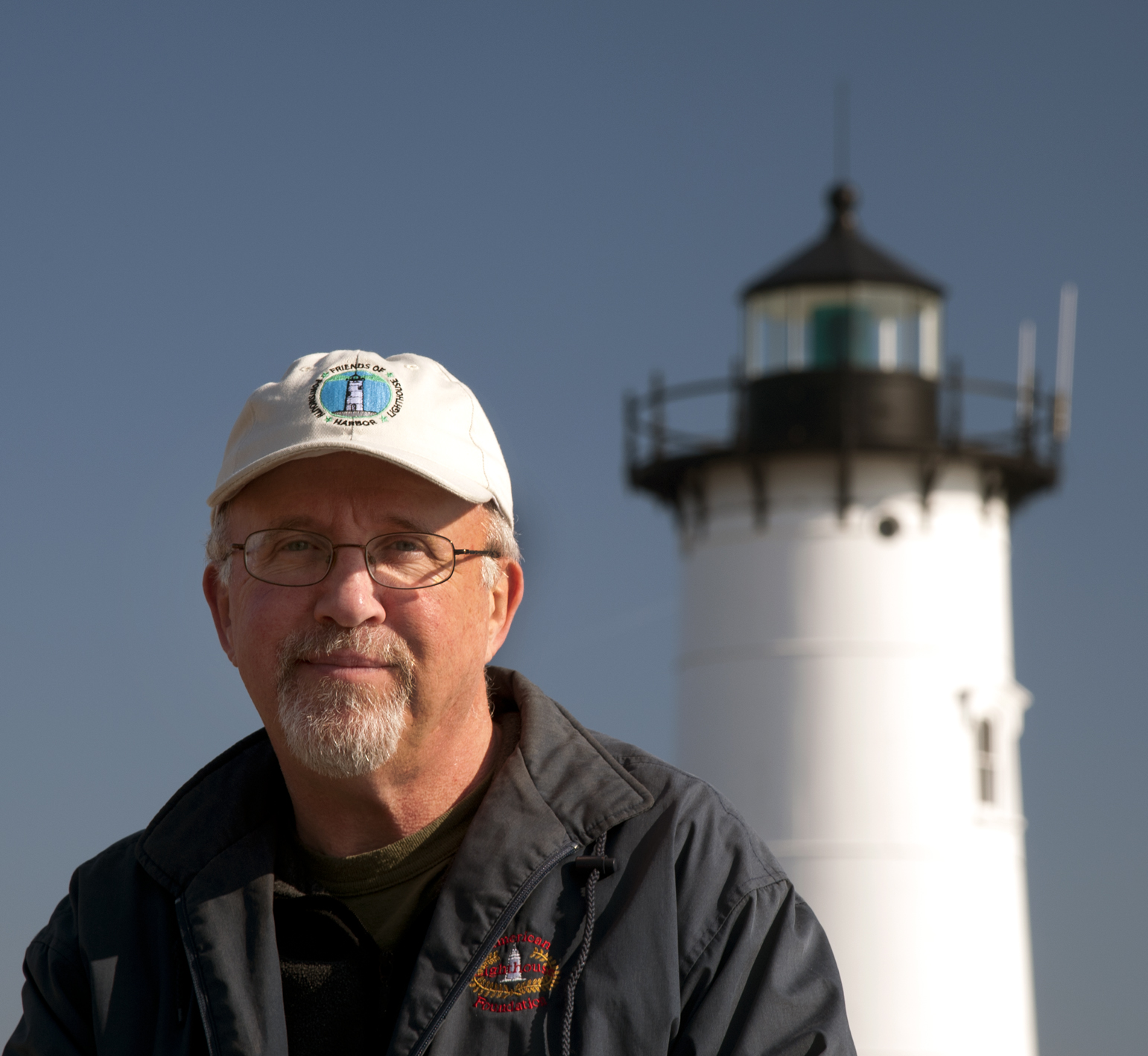
Jeremy D’Entremont is the author of more than 20 books and hundreds of articles on lighthouses and maritime history. He is the president and historian for the American Lighthouse Foundation and founder of Friends of Portsmouth Harbor Lighthouses, and he has lectured and narrated cruises throughout the Northeast and in other regions. He is also the producer and host of the U.S. Lighthouse Society podcast, “Light Hearted.” He can be emailed at Jeremy@uslhs.org

